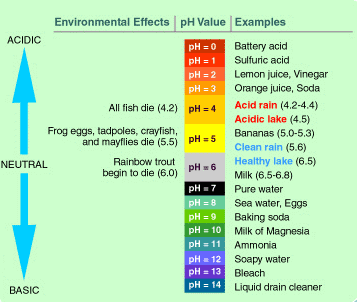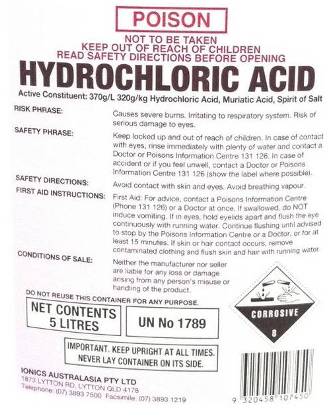pH scale

 8.3 The pH scale (2 hours)
8.3 The pH scale (2 hours)
Pause for thought
The pH scale goes from 0 to 14

A question to consider: Does 10.0 mol dm-3 hydrochloric acid solution (see below) have a pH of minus 1?
 In this sub-topic pH is defined as being equal to minus the logarithm to the base ten of the hydrogen ion concentration, i.e.
In this sub-topic pH is defined as being equal to minus the logarithm to the base ten of the hydrogen ion concentration, i.e.
pH = – log10[H+(aq)]
For hydrogen ion concentrations between 1.00 mol dm-3 (pH = 0) and 1.00 x 10-14 mol dm-3 (pH = 14) there is no contradiction between this definition and the fact that the pH scale goes from 0 to 14. However what happens when we have a hydrogen ion concentration of 2.0 mol dm-3 ? This is actually the case with normal bench 'dilute' hydrochloric acid solution. Now the pH = – log10 2.0 which is equal to – 0.30. Similarly the pH of 10.0 mol dm-3 hydrochloric acid solution will be ﹣1 according to the definition. One of the statements must be wrong. Either the pH can have a value below zero - and above 14 (in the case of 2.0 mol dm-3 NaOH(aq) for example) - or the lowest value it can have is zero.
There would appear to be two reasons why pH does not have a negative value. Hydrochloric acid is a strong acid, i.e. it is completely dissociated into its ions in aqueous solution. Perhaps this assumption is wrong for more concentrated solutions. If we have 2.0 mol dm-3 hydrochloric acid solution it does not follow that it is completely dissociated and Ostwald's dilution law which is for weak electrolytes (such as ethanoic acid) may also apply to more concentrated solutions of strong acids. Certainly if water is added to quite concentrated sulfuric acid (don't do this in practice! - the short (5 seconds!) video below shows the safer practice of the acid being added to water) a considerable amount of heat is given out as the ions become hydrated so clearly some reaction is taking place when solutions of concentrated strong acids are diluted.
The second reason is that although the mathematical statement pH = – log10[H+(aq)] is correct, the word definition that pH equals minus the logarithm to the base ten of the hydrogen ion concentration is not correct because the square brackets do not actually represent concentration. The square brackets around the hydrogen ion, [H+(aq)], actually refer to the activity not the concentration. For dilute solutions the activity is virtually the same as concentration but for more concentrated solutions it is considerably less and hence the value of – log10[H+(aq)] does not drop below zero. Who said Chemistry is easy?
Nature of science
The syllabus implies that the pH scale is an example of Occam's razor as it is an attempt to scale relative acidity over a wide range of H+ concentration into a relatively simple number. This seems completely wrong as Occam's razor is concerned with the simplest theory or explanation whereas the pH scale is neither of these. It is simply a logarithmic scale of the hydrogen ion concentration in aqueous solution.
Learning outcomesAfter studying this topic students should be able to: Understand:
Apply their knowledge to:
| Clarification notesNo assessment of pOH will take place. This sub-topic only refers to strong acids and bases. Knowledge of how the value for Kw depends upon temperature is not required. Either H+ or H3O+ may be used in equations and questions to represent a proton in aqueous solution. International-mindednessNothing is listed on the syllabus under this heading. |
Teaching tipsAs an introduction to this topic it can be useful to give your students (or better still ask them to bring in from home) examples of everyday substances such as some of those listed in the chart above and get them to test the pH value experimentally using universal indicator paper. It can also be useful to get them to use some other common indicators such as phenolphthalein, methyl orange and litmus. Once they have the idea of the pH scale then you may need to explain logarithms to the base ten to them before they can really get to grips with the definition of pH. As well as actually solving problems using the ﹣log10 [H+(aq)] definition it is useful to get them to understand qualitatively what the effect on the value of pH will be when an acid or alkali is diluted tenfold or one hundredfold. It is also worth getting them to understand that pH depends on the concentration of the solution (i.e. the hydrogen ion concentration) not on the volume of solution present. They will need practice at both converting the hydrogen ion concentration into a pH value and being able to work out the hydrogen ion (or hydroxide ion) concentration from the pH value. At Standard Level they only need to do the calculations for strong acids and bases although if your students go on to do Option B : Biochemistry then they will need to be able to extend this to buffer calculations which does involve Ka or Kb and weak acids and or bases. To get them used to a pH meter you can give the students 0.1 mol dm-3 hydrochloric acid solution and get them to dilute it tenfold successively and repeat the process with 0.1 mol dm-3 sodium hydroxide solution. Although titration curves are no longer on the syllabus, one way to fulfill the mandatory laboratory component is to get your students to do an acid-base titration using a pH meter to further reinforce the concept of pH. | Study guide
Pages 60 - 61 QuestionsFor ten 'quiz' multiple choice questions with the answers explained see MC test: The pH scale. For short-answer questions which can be set as an assignment for a test, homework or given for self study together with model answers see pH scale questions. Vocabulary listpH IM, TOK, Utilization etc.See separate page which covers all of Topic 8 Practical work |
Teaching slides
Teachers may wish to share these slides with students for learning or for reviewing key concepts.
Other resources
1. A basic outline of the pH scale with examples of substances with different pH values over the whole pH range
2. This video is also fairly simple but does explain how the scale arises using the definition of pH and the hydrogen ion concentration.

 IB Docs (2) Team
IB Docs (2) Team 

















